How Eid is celebrated all around the world
One of the most joyous Muslim occassions, Eid-ul-Fitr is widely celebrated in all those nations wherever there is a presence of a Muslim community. Read on to know more.
One of the most joyous Muslim occassions, Eid-ul-Fitr is widely celebrated in all those nations wherever there is a presence of a Muslim community. If you like reading about Eid Celebrations Around the World, just click here and forward this page to those you love. Have a happy festive time!
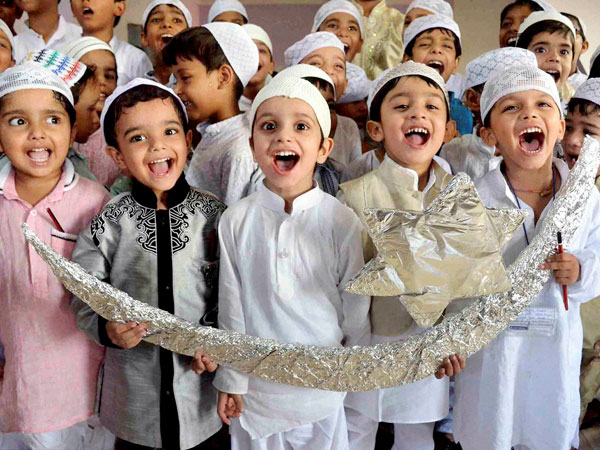
Source - oneindia
Marking the conclusion of the fasting month of Ramadan is Eid al-Fitr. This is related to the communal aspects of the fast, which depicts many of the basic values of the Muslim community, for example charity, empathy for the poor, steadfastness, patience, worship, etc. It is believed by some scholars that fasting is done to extol fundamental distinctions, praising the power of the spiritual realm, simultaneously acknowledging the subordination of the physical realm. It also teaches a Muslim to strafe away from worldly desires and to focus completely on the Lord and acknowledge Him for His blessings. At the end of Ramadan, is the big celebration of Eid.
The Indian Subcontinent
The night before Eid, on the Indian subcontinent, is called Chaand Raat, meaning, "Night of the Moon." Muslims in these countries will often visit shopping malls and bazaars with their families for Eid shopping. Females, especially younger girls, will often apply the traditional henna or Mehndi, on their hands and feet and wear vibrant bangles.
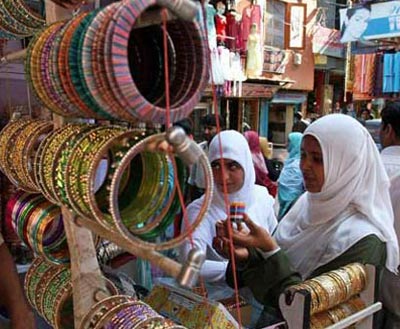
Source - zawaj
There were many popular places in India for Muslims to convene to celebrate Eid at this time include the Mecca Masjid in Hyderabad, Aishbagh Idgah in Lucknow, Jama Masjid in New Delhi. There is a prayer held on Red Road in Kolkata. Muslims turn out in thousands, as there is a lot of excitement accompanying the celebration of this festival. It is popular for non-Muslims to visit their Muslim friends and neighbors on Eid to pass on their best wishes. In the city of Hyderabad, Eid is celebrated grandly, as it has rich Islamic Heritage. During the month of Ramadan, a type of meat stew, Hyderabadi haleem, is a popular dish. It takes centre stage and becomes the main course at during Iftar, i.e., the infringement of the fast.
Egypt
In Egypt, Eid al-Fitr is a three-day feast and an official holiday, with vacations for, universities, schools and government offices. Several stores and restaurants are also closed during Eid.

Source - egyptianstreets
The Eid day begins with a small snack which is followed by Eid prayers in assemblage attended by children, men and women in which the Egyptians are reminded by the sermon, of the good deeds and virtues they should practice unto others, even strangers, during Eid and also throughout the year.
Friends, relatives and neighbors start greeting one another afterwards. The most popular greeting is "Eid Mubarak." Family visits are considered mandatory on the first day of the Eid, so they can enjoy the other two days to enjoy by going to cinemas, parks, theatres or the beaches. Some like to go on a Nile cruise or on tours. One favorite spot popularly considered for spending holidays in Egypt is harm El Sheikh.
Children are normally gifted new clothes to wear throughout the Eid. Also, women, especially mothers, wives, sisters and daughters are generally gifted special gifts by their loved ones. It is compulsory for children to also receive, from their adult relatives, an Eid-ey-yah. This is a minor amount of money that the children are given and is utilized to spend on all their activities throughout the Eid. Children will put on their new clothes and go out to gardens, amusement parks or public courtyards based on how much their Eid-ey-yah can afford. The amusement parks can range from the huge ones on the outskirts of Cairo-Nile, Felucca Nile rides being a common feature of Eid celebration in Egyptian towns, villages and cities.
Egyptians prefer to celebrate with others so the streets are always crowded during the nights and days of Eid.
South Africa
Hundreds of Muslims will gather at Green Point in Cape Town in the evening of the concluding day of Ramadan each year for sight of the moon. The gathering brings people together from all walks of life, and everyone bring something along to share with others at the time of infringing the fast. The Maghrib or sunset prayer is then performed in congregation and the formal moon-sighting results are announced thereafter.
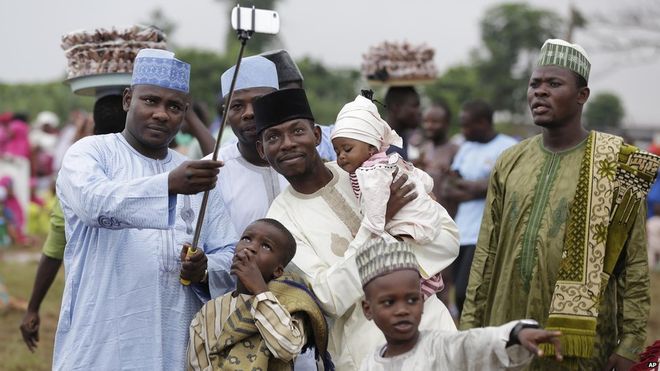
Source - eagle
By attending the mosque first thing in the morning for Eid prayer, the festival of Eid al-Fitr is celebrated. This is followed by visiting neighbors and relatives. Children receive money and presents from elder members of the neighbors, relatives and family. Most people wear new clothes with vibrant colors, while cakes, biscuits, pies, samosas and tarts are served to visitors as treats. Lunch is generally served in family groups. It is also mandatory to exchange gifts
Nigeria
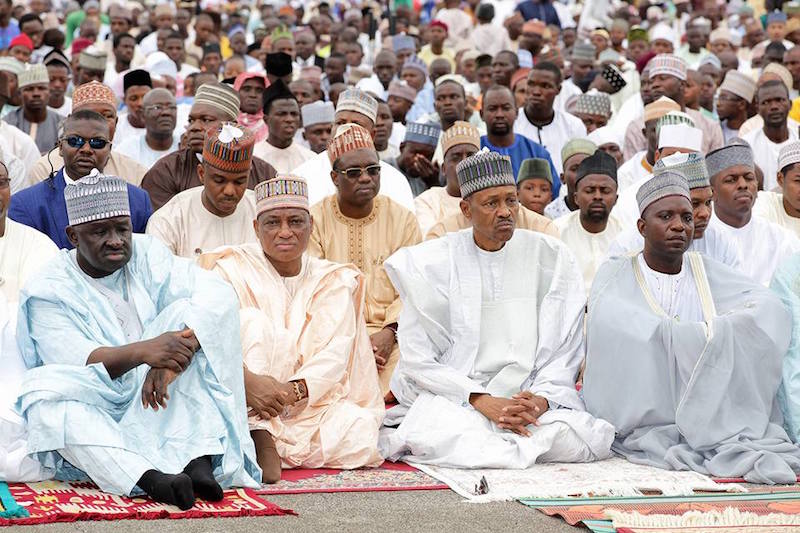
Source - bellanaija
Nigeria is officially a non-clerical country and is populated by substantial numbers of Christians and Muslims. In Nigeria, Eid is commonly known as "Small Sallah" and people generally greet one another with the customary greeting: "Barka Da Sallah," meaning "Greetings on Sallah" in the Hausa language. Muslims observe their Eid prayers at assigned praying grounds before heading home to take part in festive meals, usually prepared by the females of the household. The Federal holiday generally goes on for two days in Nigeria.
Saudi Arabia
Eid al-Fitr is celebrated with great affectation in Saudi Arabia. Saudis prepare sumptuous meals for family and friends and decorate their homes.
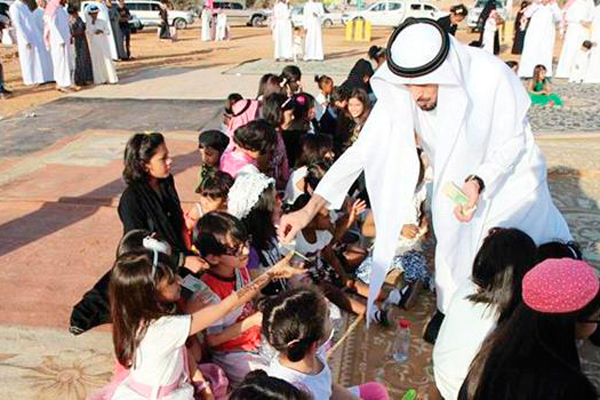
Source - tradearabia
In Saudi Arabia, Eid festivities may vary culturally depending on the region, but one common tie in all celebrations is of hospitality and generosity. Firstly, to gather at the patriarchal home after the Eid prayers, is common Saudi tradition for families. Young children will line up in front of each adult family member before the special Eid meal is served, who will dispense Riyals, Saudi currency, as Eidi to the children. Family members will also typically have a particular time where they will distribute gift bags to the children. These bags are often wonderfully decorated and contain toys and candies.
It is also common in some areas for Saudi men to go and purchase large quantities of rice and other staples and then anonymously leave them at the doors of those who are needy and less fortunate. In some areas in the middle of Saudi Arabia, for instance Al Qassim, it is a common tradition during Eid that on the morning and after the Eid prayer, people will put large rugs on one of the streets of their neighborhood and each household will cook a large meal where these meals will be shared by all neighbors. It is also a common practice that people will exchange places to try more than a particular kind of meal.
Turkey
In Turkey, it is a public holiday, where government offices and schools are generally closed for the whole three-day period of the festivities. The celebrations of this bayram are incorporated with national traditions. It is mandatory for people to greet one another with Bayram?n?z kutlu olsun or Bayram?n?z mübarek olsun. Mutlu Bayramlar is an alternative phrase for celebrating this bayram. It is a period for people to visit prayer services, wear their best clothes, which are referred to as bayraml?k, and often purchased just for the occasion, visit all their loved ones, including relatives, neighbors, and friends and pay their respects to the departed with customary visits to cemeteries, where temporary, large bazaars of flowers, water, used for watering the plants adorning a grave, and prayer books are erected for the three-day occasion. Generally, the first day of the bayram is considered to be the most important, with every family member waking up early, and the men attending their neighborhood mosques for the special bayram prayer.
Fund-raising events for the poor are organized by municipalities all around the country, in addition to public shows like concerts or more traditional forms of entertainment such as the Hacivat and0 Karagöz shadow-theatre and even performances by the Mehter, which is a Janissary Band founded during the days of the Ottoman Empire.
Afghanistan
Eid al-Fitr holds significant importance in the predominantly Sunni Muslim culture of Afghanistan and is celebrated widely for three whole days. The most popular greeting is Eid Mubarak. Among the Pashto-speaking community this Eid is called Kochnai Akhtar.
On the day of Eid al-Fitr, Afghans will offer their Eid prayers first and then get together in their houses with their families, greeting one another by saying "Eid Mubarak" and usually adding "Eidet Mobarak Roza wa Namazet Qabool Dakhel Hajiha wa Ghaziha," which means "Happy Eid to you; may your prayers and fasting be acknowledged by God, and may the Hajj-pilgrimage involve you carrying it out ." Elders in the family will distribute gifts and money gifts to children. It is also customary practice to visit families and friends, which may be hard to do at other times of the year. Children walk from door to door and say "Khala Eidet Mubarak" and they receive cookies or Pala.
Indonesia
In Indonesia Eid is known as Idul Fitri, and popularly as Lebaran, and is a national holiday. Bazaars and shopping malls are usually filled with people to get things for Lebaran like new shoes, sandals, clothes and also food to provide for the days ahead of Idul Fitri, which creates a distinct festive atmosphere throughout the country, along with the usual traffic mayhem. Several banks, government and private offices are closed for the duration of the Lebaran festivities.
The night prior to Idul Fitri is called takbiran. It is filled with the sounds of musallahs, people usually filling the street and also chanting takbir and those of many muezzins chanting the takbir in the mosques. Pelita or oil lamps, which are no different from tiki torches, are set alight and placed outside and around homes in many parts of Indonesia, and particularly in the rural areas.
On Eid al-Fitr, It is mandatory for Indonesian Muslims to wear traditional cultural clothing. Baju koko, a collarless long or short-sleeve shirt with traditional embroidered designs with a "kilt" sarung of songket, ikat or similarly woven, plaid-cloth, and songkok, which is a headwear, is the standard Indonesian male outfit. On the contrary, men may either wear more traditional loose-fitting trousers with colour-matched shirts and Western-style business suits, topped with a peci hat. Traditional female dress is called kebaya kurung. It generally consists of, a loose-fitting kebaya blouse, which might be enhanced with brocade and embroidery, the sarung skirt made of batik, ikat or songket or a long skirt both of which may be batik, and either the jilbab or its variant the stiffened kerudung.
It is common for many Muslims in both Indonesia to visit the graves of loved ones post celebrations. They will clean the grave, perform the tahlil ceremony and recite Ya-Seen, a chapter from the Quran during this visit. In Indonesia there is a special ritual called halal bi-halal. This could be done several days after or during Idul Fitri.
Malaysia
In Malaysia, Eid is more popularly known as Hari Raya Aidilfitri where Hari Raya means 'Celebration Day'.
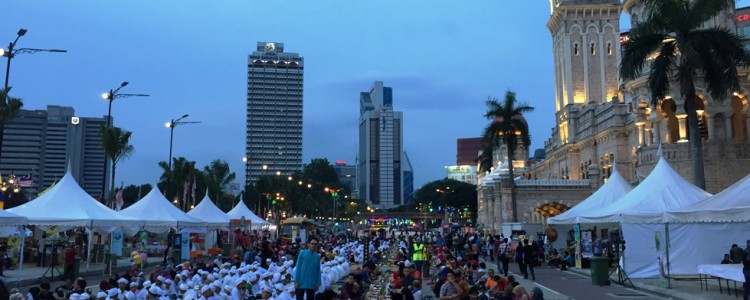
Source - itc
It is mandatory for workers in the city to return to their home towns to enjoy with their families and to plead forgiveness from elders, parents and in-laws. This is known as balik kampung or homecoming in Malaysia.
People take turns to define a specific time for open house when they stay at home to entertain and receive family, neighbors and other visitors in Malaysia, especially in the major cities. It is not uncommon to see non Muslims made welcome during Eid at these open houses. They also adorn by lighting traditional bamboo cannon firecrackers known as meriam bambu Ramadhan, or as meriam buluh in Malaysia, utilizing kerosene in Chinese imported crackers or large hollow bamboo tubes. The traditional bamboo cannon, meriam bambu, and fireworks are very loud and can be very hazardous to the operator, nearby buildings and bystander. These are usually bamboo tubes 5–10 cm in diameter and 4–7 m long, filled with either water or heated kerosene or several hundred grams of calcium carbide and then set alight by match.
In the early morning during Ramadan, celebrating with firecrackers is now banned in many areas though many vandals bypass the law and disturb the neighborhood.
In Malaysia, children are given small amounts of money, also known as "duit raya", from their elders or parents.
Philippines
Eid al-Fitr, known to the Christian majority and other non-Muslims in the Philippines as "Wakás ng Ramadán" or incorrectly as "Ramadan", has been considered a regular holiday by the Philippine Government due to the Republic Act No. 9177 and also according to Presidential Proclamation No. 1083, signed into law on 13th November, 2002, the only Christian country in the world to have done so. This law was brought about in deference to the Filipino Muslim community and to promote harmony and peace among major religions in the Philippines. The first national ritual of Eid al-Fitr, on December 6, 2002, was marked by celebrations and prayers by the Muslim community. Several of the Filipino Muslims will attend grand congregation like Qurino Grandstand and Manila Golden Mosque every Eid.
Myanmar
Eid al-Fitar goes on for but one day among Burmese Muslims, who call the day Eid Ka Lay or Eid Nei’ or Shai Mai Eid. Burmese Muslims predominantly pursue courses in Sunni Islam in the Hanafi School of jurisprudence.
The Eid al-Adha "Greater Eid" or "Festival of Sacrifice" is a public holiday in Burma as this event falls yearly on the month of Dhu al-Hijjah, the 10h day, in the lunar Islamic calendar. Eid al-Adha is only observed for a single day in Burma, not alike Muslim countries that observe a three-day festival. During both the Eids, the traditional greeting is merely the popular Islamic greeting of Assalamualaikum, and Eid Mubarak is only rarely heard. The greeting is followed by placing the right hand on the forehead, as if conveying a salute. There is no shaking of hands and seldom only includes a formal embrace.
Food and gifts are frequently offered to the elder relatives and even to government authorities and non-Muslim employers. Burmese Muslims elders will offer Eidi gifts to children while new clothes are usually given to family members and coworkers. Children will receive token sums of money, even from strangers, especially if they went around the neighborhoods forming groups just for the purpose of collecting Eidi. It is not uncommon for young people and children to go around giving greetings of "salaam" to elder relatives, parents, and other elders in the community. Burmese Muslims beg for forgiveness from elders and parents and try to forget and forgive any misunderstandings themselves that may have occurred amongst one other during Eid.
China
Out of 56 officially recognized ethnic groups in the People's Republic of China, Eid al-Fitr is celebrated by at least 10 ethnic groups which are predominantly Muslim. According to official statistics, these groups are said to total almost 18 million, but some observers say the actual number is probably much higher. In certain regions of China, including two Province Prefecture Level regions, Xinjiang and Ningxia, it is also a public holiday. Regardless of religion, all residents in these areas are entitled to either a three-day or one-day official holiday. Only Muslims are entitled to a one-day holiday outside the Muslim-majority regions. Eid al-Fitr is even celebrated by Han Chinese population in Xinjiang province, during which holiday supplies of beef, lamb and mutton are distributed to households as part of welfare program which is funded by private and public institutions and government agencies.
Australia
In Australia, a predominantly non-Muslim, non-clerical country, Muslims are able to celebrate their religion with immense freedom. Most large companies allow for special religious holidays allowing Muslims to take one day off for Eid al-Fitr. Areas where there is a large Muslim population have packed attendances at the mosque for the Eid al-Fitr prayer. Police often block roads off and divert traffic to serve for the prayer and subsequent celebrations. Eid prayers are also held in open areas such as playgrounds or stadiums, in some places.
United States of America
In the United States, most Muslims offer the Eid prayer in Islamic centers, open parks or convention halls. Muslims from different cultures with multi-national customs gather for celebrations and prayers. Prayers are practiced multiple times to accommodate the large number of attendees in some cities. Muslims generally visit one another’s homes on Eid or hold large feasts in community halls or mosques. Mosques, sometimes, rent parks for Muslims to pray in.
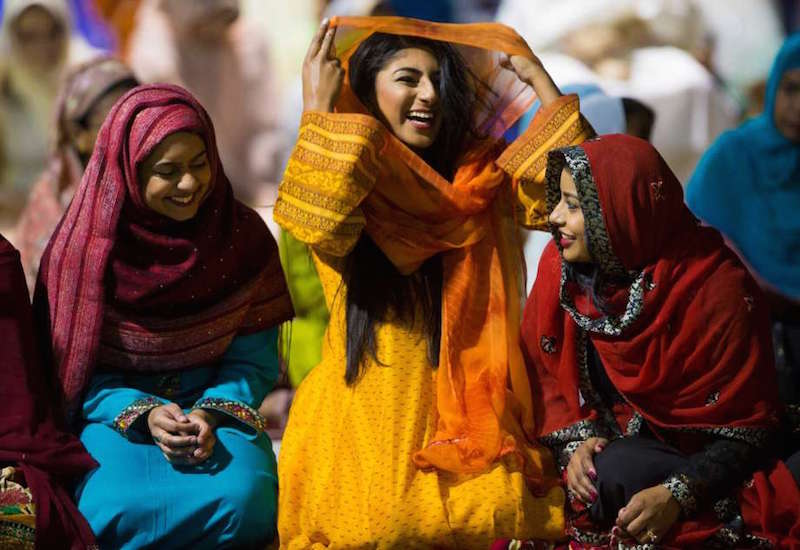
Source - hdnux
Many Muslims join big parties funded either by an Islamic center or community mosque or by a wealthy Muslim in the community, during the 3 days of Eid. Children receive gifts, and all participants enjoy spicy, sweet and other flavorful delicacies. Many Muslims also provide money to those who are not so fortunate. Sometimes, Muslims book skating rinks, amusement parks or other activity centers for a whole day of fun.
The Postal Service of the United States has issued several Eid postage stamps, across several years, beginning from 2001, honoring two of the most prestogious festivals in the Islamic calendar, Eid al-Fitr and Eid al-Adha.
Canada
Just as in the United States, a majority of the Canadian Muslims will take a day off from work and attend the prayers held at Islamic centers, convention halls, in big-city mosques or sports arenas for Eid al-Fitr. Muslims from different cultures with multi-national customs gather for celebrations and prayers.
Mosques and muslim organizations also arrange large Eid parties that are open to the whole Muslim community, in several Canadian communities. Some groups might reserve activity centers or amusement parks for an entire day of festivities and celebration, while others can hold public Eid parties in mosques as a means of reaching out to the larger non-Muslim society.
Students from Canadian schools usually take two to three days off, due to the fact that Eid is such a major holiday in the Islamic culture.
United Kingdom
Although Eid al-Fitr is not considered to be a public holiday in the United Kingdom, many Muslims do attend the prayer in the morning. Local businesses and schools often grant exemptions to the Muslim community because of this holiday, enabling them to take days off, in large ethnically Muslim areas.
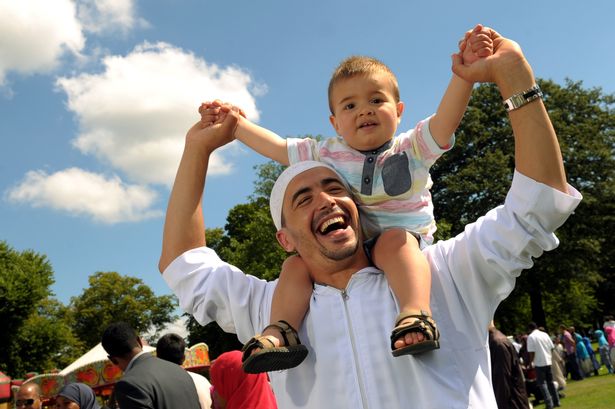
Source - birminghammail
Men of South Asian descent usually wear a jubba, thawb and sherwani, and women usually put on a salwar kameez during the morning. They will make their way to a local mosque for the Eid prayers, after which people greet one another. Some men may go to a local cemetery after Eid prayers to pay their respects to the departed and pray for them. Once they return home they will congratulate friends, family and other Muslims and pay a visit to relatives across the city. They might also cook cultural food and sweets for their relatives. Pakistani dishes such as Handesh, Noonor Bora, and Fulab and Bengali dishes such as samosas, Siweya, Rice are especially popular within those communities.
Mauritius
Mauritius is a diverse island nation where various religions live together in communal harmony. Muslims take up about 16.6% of the total population and Eid is considered a national holiday of this island, one of many. Eid itself is celebrated across the island, with the cooking of a feast, which mainly includes the "biryani". Men accomplish their Eid prayer at the Eid Gah or at the local mosques. In the days that follow Eid, cultural shows are usually performed.
Fiji

Source - jafrianews
Muslims consist of around 7%, or 63,000 people, of the total population of Fiji, a tiny tropical island-nation northeast of Australia. The Muslim community majorly comprises people of Indian origin, descendants of obligated laborers who were brought to the islands in the early 20th and late 19th centuries by the British colonialists. There is also belief to be a few hundred indigenous Fijian Muslims in the island nation, although no accurate statistic evidence exists. The large majority of Muslims in Fiji are of the Sunni branch of Islam who pursue courses in the Hanafi School of jurisprudence.
Eid al-Fitr is celebrated in Fiji with Muslim men wearing their prized clothes and visiting the mosque for the early morning congregational prayer. In most parts of Fiji, women do not go to the mosques for prayers. This is followed by visiting neighbors and relatives. Children receive money and presents from relatives, elder members of the family, and neighbors. Most Muslims will wear brand new clothes on this day, and serve a dish of sweet, fine vermicelli noodles mixed in warm milk known as samai. This is usually complemented by curried chicken, samosas and beef as well as sweets and Indian deliights for guests visiting throughout the day.
The customary Eid greeting is Eid Mubarak, and it is often followed by a formal embrace.
Source - theholidayspot
Can also read - Home Decor Ideas for Eid